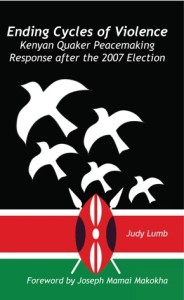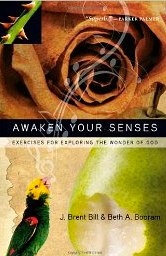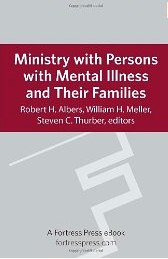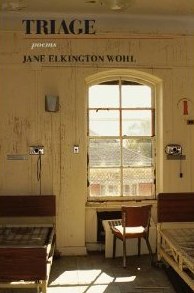Books January 2013
Staff
December 26, 2012
Ending Cycles of Violence: Kenyan Quaker Peacemaking Response after the 2007 Election
By Judy Lumb. Producciones de la Hamaca (Belize) and Madera Press, 2012. 133 pages. $24/paperback.
Reviewed by Henry Apencha and Rosalie Dance
 Ending Cycles of Violence recounts the peacemaking work of Friends in Kenya in the violent aftermath of their 2007 national election. Judy Lumb, a volunteer with the African Great Lakes Initiative, interviewed 34 participants in the peacemaking response and tells their story in their own words. For context, Lumb provides a brief history of conflicts from British brutality during colonial Kenya, the Mau Mau uprising, land reform after independence, centralization of power, suppression of political opposition, violence sponsored by politicians, and pre- and post-election violence in 1992 and 1997 to help the reader gain insight into the significance of the work that Kenyan Friends did.
Ending Cycles of Violence recounts the peacemaking work of Friends in Kenya in the violent aftermath of their 2007 national election. Judy Lumb, a volunteer with the African Great Lakes Initiative, interviewed 34 participants in the peacemaking response and tells their story in their own words. For context, Lumb provides a brief history of conflicts from British brutality during colonial Kenya, the Mau Mau uprising, land reform after independence, centralization of power, suppression of political opposition, violence sponsored by politicians, and pre- and post-election violence in 1992 and 1997 to help the reader gain insight into the significance of the work that Kenyan Friends did.
Tensions rose during the long delay between the December 27, 2007 election and the announcement of its results. When a press conference announcing results finally came, it was followed immediately by a private swearing-in of the announced winner. Both the announced results and the surprising follow-up were regarded with suspicion by many Kenyans, and the losing party, Orange Democratic Movement, called for organized civil disobedience. Police blocked the sites for planned actions. Suddenly, resentment held over from previous elections, power inequities, unresolved land disputes, and economic inequities fueled the animosities brewing in the current situation. When violence erupted, thousands of people were driven from their homes; more than a thousand people died. Homes were razed, crops destroyed, farm animals stolen, and businesses looted.
People who escaped were sent to Internally Displaced Persons (IDP) camps. The largest of the IDP camps were assisted by organizations like the Red Cross. Smaller IDP camps were ignored by the big organizations, so Friends focused their efforts on those. Friends for Peace and Community Development, an established organization, worked first in western Kenya and later also in Nairobi. Friends Church Peace Teams, established to respond to the immediate violence, also worked in western Kenya. Nairobi Friends worked independently in the city of Nairobi and in nearby Rift Valley.
Through interviews with Friends who lived through these times, Lumb gives us an account of very personal experiences of peacemaking. Kenyan Friends responded quickly with courage and hard work to the violence that broke out. Friends worked not only with the victims of the violence, but also with the perceived perpetrators, listening and helping people to heal from the trauma. In addition to healing work, Friends used their skills from the Alternatives to Violence Project (AVP) and the Healing and Rebuilding our Communities (HROC) workshops developed in Rwanda and Burundi to provide training in alternatives to violence conflict resolution. Friends’ responses provided a mode for peacemaking within communities.
To garner attention at the national level, the Quaker Peace and Justice Committee of Nairobi Yearly Meeting, in consultation with Friends in other parts of Kenya, addressed a pastoral letter to the “leaders of the nation.” The committee delivered it to the principal contenders for the presidency and sent a copy to Kofi Annan, secretary general of the United Nations. The letter, reprinted in Ending Cycles of Violence, is a beautiful statement of the Quaker peace testimony made specific to Kenya’s current condition. A second letter from Kenyan Quaker leadership was addressed to the “leaders and citizens of Kenya” and widely distributed in the media, which publicized stories of people acting courageously and nonviolently to stop violence and retaliation.
With this account, Judy Lumb provides the world with a case study in ending cycles of violence using listening, conflict resolution, and trauma healing. But Kenyan Friends’ work is being tested again, and they need our support. They were supported in 2008 by international funds channeled through Friends organizations, including Friends United Meeting, Friends Peace Teams/African Great Lakes Initiative, Britain Yearly Meeting, Change Agents for Peace International, and others. The 2012 election has been delayed until 2013, and tensions are rising again.
Pre-election violence is already occurring, and Friends Church Peace Team has two people working on it right now with two more about to be hired. They have trained 403 “citizen reporters” to access call-in centers to get peacekeepers to areas of conflict, but more peacekeepers will be needed. The election is now scheduled for March 4, 2013. If peace can be established before the election, we hope it can hold through the election and its aftermath.
[hr]
Awaken Your Senses: Exercises for Exploring the Wonder of God
By J. Brent Bill and Beth A. Booram. Intervarsity Press, 2012. 208 pages. $15/paperback.
 Reviewed by Valerie Brown
Reviewed by Valerie Brown
Reading Awaken Your Senses is like taking a full-bodied journey of heart, mind, and soul. Quaker author Brent Bill and his colleague Beth Booram describe a way of living that invites God’s abiding Presence and turns our faculties of seeing, hearing, touching, feeling and smelling toward prayer and toward God. They describe with clarity their commitment to living as “sensuous Christians” and offer guidance for how we might bring such open responsiveness to the Oneness that pervades All into daily life.
The book is rich with practical exercises—some easy to incorporate into daily life, and some challenging. For example, people of many religious traditions are familiar with the practice of blessing food, expressing a measure of gratitude for food. Bill and Booram recommend a more challenging 30-day practice of journaling about a physical sense as a way of exploring its spiritual dimensions.
Largely written for Christian, middle-class, mature audiences, Awaken Your Senses is filled with Bible quotations, drawings designed to elicit deeper reflection about the meaning of each sense explored, and Quaker-style queries meant to encourage a deeper experience of each sense. The point of this deliberate and thoughtful examination of the senses is to assist the reader not only to read, but to experience the work with the whole brain and body, and thus come into a deeper awareness and connection to God. Bill and Booram equate this kind of attention to an act of love. Certainly, it is an act of building and strengthening the soul.
Some of the images failed to resonate with me, such as the authors’ view of sin needing to be cleansed rather than healed by embrace and acceptance. But the book’s purpose is to provide Christian spiritual exercises that will invite an awakening of one’s heart, mind and soul to God’s abiding Love. For this, Awaken Your Senses is a useful tool with many exercises and images for guidance.
[hr]
Ministry with Persons with Mental Illness and Their Families
Edited by Robert H. Albers, William H. Meller, and Steven D. Thurber. Fortress Press, 2012. 245 pages. $29/paperback.
 Reviewed by Kirstin Backstrom
Reviewed by Kirstin Backstrom
In my own spiritual community, I have been touched by the sincerity with which others have responded to people with mental illness. Even when those responses were unhelpful, they represented genuinely caring intentions. Though I am an experienced chaplain and pastoral counselor, and more “qualified” than most to be useful, my own efforts generally don’t seem to make more of a difference than anyone else’s. Often there is no “right” response to the suffering experienced by individuals with mental illness and their families as they struggle to cope with difficult symptoms, painful social complications, and inadequate mental health support systems.
As many of the contributors to Ministry with Persons with Mental Illness and Their Families attest, the most consistently useful response that can be offered by a spiritual community is calm, caring presence—but an essential prerequisite for such a presence is understanding.
In the introduction, the book’s editors discuss the stigma attached to “unsanctioned illnesses.” With such illnesses, a self-perpetuating cycle of popular ignorance and fear creates a “conspiracy of silence,” which prevents communication of basic information and increases ignorance and fear. Those suffering from unsanctioned illnesses (including both the victim and his or her family) often experience shame and isolation as a direct result of this cycle. By acknowledging the problem and offering us information and guidance openly, this book helps to remove the stigma from mental illnesses and increases our ability to support one another effectively. Even when the only immediate solution to a crisis is to refer the situation to a mental health professional, the overall outlook is greatly improved if everyone involved is well-informed, calm, caring, and genuinely respectful. Such a perspective requires an inward attitude of openness and self-education in order to break the cycle of ignorance and fear.
Each chapter combines medical information (provided by a psychiatrist) with pastoral guidance (provided by a pastoral theologian) about a specific mental illness—including not only psychotic disorders and personality disorders, but also depression, anxiety, substance-use and eating disorders, autism, brain injury, and dementia. There is additional information about psychopharmacology, cultural context, and referrals. Some chapters offer testimonials from those who have personal experience with the illness being described—for instance, a man who is living with a brain injury, or a woman whose husband has Alzheimer’s disease—and these are among the most meaningful parts of the book. Moving personal stories, concrete data, and practical suggestions are all good ways of deepening understanding. Although the mix of these elements is not always smooth, and the clinical and pastoral voices can sometimes seem to clash, the essential usefulness of this book as a resource for spiritual communities is evident—and the need is urgent.
While the editors state their intention to assist pastors, ministers, and other church leaders with the situations involving mental illness that they may encounter in the course of their professional roles, we must recognize that in unprogrammed Friends meetings in particular, and in many other church congregations as well, it is the members and attenders themselves who may be in a position to respond to an individual or family in crisis or need. Whether the person responding is a professional, a lay member of a pastoral committee, a friend, a neighbor, or even a stranger—understanding, supported by information, is essential. It is our responsibility to provide resources like this book for ourselves and our communities, to deepen our awareness and broaden our minds. Most of us will directly experience some form of at least one of the mental illnesses described here, either in ourselves or in a loved one. Those suffering from “unsanctioned illnesses” are not “them”—they are “us.” We are all called to live out the ministry of presence and caring in our encounters with one another, and the quality of that presence may depend on the efforts we make to be present to all seekers at our meetings, whatever their conditions.
[hr]
Triage
By Jane Elkington Wohl. Fithian Press, 2012. 80 pages. $14/paperback.
 Reviewed by Michael Robertson
Reviewed by Michael Robertson
Is the finest war poetry of our time being written thousands of miles from the front lines? Homer, the great war poet of the ancient world, set the Iliad on the battlefields outside the walls of Troy, where heroes such as Ajax “split the Trojan front lines as a wild boar / In the mountains tosses dogs and men / When he turns on them in a clearing.” War is as central to Jane Elkington Wohl’s Triage as it is to the Iliad, but Wohl locates her poems in the Wyoming town where she lives and teaches. Outdoors, crocuses bloom amidst “the loam’s dry winter hue”; inside, images of smoke hanging thick above Baghdad fill the television screen.
Wohl, unlike Homer, is immune to the lure of violent spectacle; she’s interested instead in war’s effect on absent soldiers’ families and friends, on Iraqi civilians, on American citizens who, with or without our consent, are implicated in the violence waged by our nation. “Triage” comes from the French word for “sorting”; it’s used by combat medics who must separate the wounded who can be saved from those who will not survive. Wohl, resisting the pull of her book’s title, refuses to sort: Iraqi dead are as important as American; a soldier is as precious as a child; a flower is as hard a fact as a bomb.
Wohl demonstrates her ethics of equality and interconnectedness through her poetic form. The highlights of Triage are two extraordinary sonnet sequences, each 12 poems long, in which the last line of one poem becomes the first of the next, and the twelfth sonnet ends where the first began. The sequences require exceptional technical skill, but there’s nothing flashy about these poems; they’re quietly dazzling, as in “Meditation #6,” which begins with the poet holding a friend’s child in her arms, then slides into a glimpse of a violently beautiful Wyoming landscape where “sunset bleeds across the mountain’s spine.” She moves on to newspaper photos of soldiers killed in Iraq and reaches back in time to the Civil War dead of Antietam, Gettysburg and Shiloh—young men who, like the child, once had “sweet fine bones” rising from their backs “like little wings.” Just as powerful is the sequence, “News: May 2004,” which at one point glides from the poet’s former student, now a soldier, although his arms were “meant / for holding babies,” to two women—one Palestinian, one Israeli—both holding babies as they mourn their dead.
The great temptation facing the pacifist war poet is preachiness, and Wohl is not immune. “When will we learn that it’s impossible not to kill civilians?” she asks in one poem, in language as tired as the sentiment. But this is a rare lapse—Wohl understands that memorable poetry comes from startling juxtapositions of ideas and images, as in a sonnet that links violence in war and in the home as it concludes, “Behind locked / doors, the cruelty continues, grows and blooms / and far from here the great guns boom.” Wohl shows us that there’s no easy distinction between war and nature: cruelty and flowers both “bloom.”
Triage is not concerned exclusively with war. Wohl, a Quaker, knows her Bible, and the collection includes a witty poem spoken by a sexually desirous Eve, another voiced by the nameless prostitute who encountered Jesus at the well, and two poems about burning bushes—a Wyoming autumn must be glorious enough to make anyone imagine herself a Moses. Triage is a work about beauty and pain, desire and mourning, violence and compassion, by a poet possessed of impressive wisdom and skill.
[hr][hr]
In Brief
“In Brief” Reviews submitted by Karie Firoozmand, Stony Run Meeting of Baltimore, Md., unless otherwise noted.
Better Not Blink
By Lydia Caros. Xlibris, 2011. 61 pages. $15.99/paperback, $3.99/eBook.
In this first volume of poems, Lydia Caros, longtime Friend from Minnesota, concerns herself with time itself. Even though it seems to pass quickly, time can teach us things if we pay attention. On this she meditates in the book’s three segments, called “Messages from Nature,” “People,” and “Musings.” Ms. Caros calls this book her attempt to write about time and where she is in it. As her introduction tells us, “I’ll be using the rest of my time exploring that.”
[hr]
Dirt and the Good Life: Stories from Fern Creek
By Lisa Graham McMinn and Mark R. McMinn. Barclay Press, 2012. 208 pages. $14.95/paperback, $9/eBook.
The authors, both professors at George Fox University, share stories of their openings while living on their small farm and tending the earth, each other, their family and friends, and their spiritual lives. The stories reveal the authors’ real and living gratitude for their chance to be stewards of the dirt, both the literal earth and the spiritual ground they inhabit.
[hr]
From Southern Belle to Global Rebel: Memoirs of Anthropologist and Activist Mary Lindsay Elmendorf
By Mary Lindsay Elmendorf. Sharon Fitzpatrick Productions, 2012. 342 pages. $15/paperback.
Elmendorf begins the memoir with a description of her parents, and continues it chronologically, ending with plans for her 95th birthday in 2011. Elmendorf and her husband worked on world issues and raised their family; they shared in the honor of the 1947 Nobel Peace Prize for work in Europe during and after World War II. Hers is a full life represented with dozens of charming photos (not all of which have captions).
[hr]
Gandhi and the Unspeakable: His Final Experiment with Truth
By James W. Douglass. Orbis Books, 2012. 176 pages. $24/hardcover.
Gandhi is a person and a topic of perennial interest, and this slim volume adds to the body of interpretation of his experiments with Truth. Douglass examines the possibility that political motivation abetted Gandhi’s assassin. The book also explores Gandhi’s early confrontation with death and overcoming his fear of it. Douglass applies Gandhi’s form of political resistance to the issues of today. The index that follows the endnotes will be particularly of use to those doing research about Gandhi’s life.
[hr]
Gandhian Quaker, Convict and Peace Teacher: Lee Stern, World War II Conscientious Objector
By Caroline Besse Webster. Creative Response to Conflict, 2012. 331 pages. $30/paperback, available through Quakerbooks of FGC.
Webster, in authoring this biography, is clearly inspired by her long friendship with Lee Stern. Stern served in various administrative positions in New York Yearly Meeting, where his influence was for teaching peace by teaching nonviolence. His life events will be of interest to Friends familiar with World War II conscientious objection, Vietnam War protest, the Fellowship of Reconciliation, and Creative Response to Conflict. A glossary of Quaker terms precedes the text and a bibliography and index follow it.
[hr]
Historical Dictionary of the Friends (Quakers)
Edited by Margery Post Abbott et al. Scarecrow Press (second edition), 2011. 598 pages. $79.11/hardcover.
Part of a series of dictionaries of various religions, this chunky volume edited by four Friends is an extremely valuable reference. The 2003 edition is available as an eBook ($79.99 on Amazon), but so far this one is only available in hardcover and certain to include improvements. This dictionary is enjoyable to browse and helpful as a reference. It contains over 700 entries, some on little-known Quakers and movements within Quakerism. It also includes a bibliography for further reading.
[hr]
Howard Zinn: A Life on the Left
By Martin Duberman. The New Press, 2012. 318 pages. $26.95/hardcover (also available as an eBook).
Martin Duberman acknowledges in the introduction that this biography treats almost exclusively Zinn’s long, active and very public efforts due to the paucity of source materials on his personal life. Near his death, Zinn destroyed many documents that would have revealed his personal relationships and inner life, which Duberman calls a clear signal that Zinn did not want his biographers to research that material or emphasize it in his biography. Duberman still put significant effort into research, which includes interviews with Zinn’s friends.
[hr]
Supportive Care in the Congregation
By Dean A. Preheim-Bartel et al. Mennonite Publishing Network, 2011. 96 pages. $8.99/paperback.
After We’re Gone
By Duane Ruth-Heffelbower. Mennonite Publishing Network, third edition, 2011. 62 pages. $8.99/paperback.
These companion books both cover the subject of congregations (or meetings) supporting individuals with significant disabilities and their families. Supportive Care in the Congregation provides a model for care, ministry, and advocacy. After We’re Gone has clearly laid out chapters on topics like establishing a trust and setting up a guardianship for the care of a disabled child or adult child. Both contain resource and reading lists and topic indexes.
[hr]
The Legacy They Gave to Us: Early Quakers in Strand Parish, Norway
By Matilda Hansen. Commentary Press of Wyoming, 2010. 224 pages. $18/paperback.
This volume is first in a trilogy that traces the history of Strand Parish Quakers in Norway. In historical novel form, Matilda Hansen tells the story of her Norwegian ancestors of the nineteenth century. At that time, Quakerism came to Norway in the form of ministry by men who had been prisoners of war in Britain. The Lutheran Church in Norway did not welcome them, and Hansen’s own forefathers and mothers bore the brunt of persecution. Later many family members immigrated to America, and several pages of genealogy and a “cast of characters” follow the text. This “novel” is likely to be of particular interest to Iowa Friends.
Twenty Odd Tales, Including the Orinoco Stories
By John Schoonbeek, illustrated by Karen E. Gersch. Hudson House Publishing, 2011. 154 pages. $7.99/paperback.
The cover proclaims this as 21 “irreverent stories tracing the triumphs and follies. . . as told by their gay grandson” of a clan of Dutch immigrants. Friend Schoonbeck’s stories have been published in Friends Journal in the past, and readers will enjoy the storyteller’s skill in this collection.
[hr]
William and Sarah Biddle (1633-1711): Planting a Seed of Democracy in America
By C. Miller Biddle. Published by C. Miller Biddle, 2012. 400 pages. $38/paperback.
C. Miller Biddle began research for this book over thirty years ago in order to answer family questions about their ancestors and their motivations for immigrating to the Delaware Valley. It turns out that they were among the earliest Quakers to settle in the area, and they contributed to the development of the area’s government. This book includes helpful and illustrative maps as well as an appendix listing contemporaries of the Biddles and their meetings; it also has endnotes and an index. This clothbound book can be ordered from C. Miller Biddle at P.O. Box 714, Moorestown, N.J. 08057.
[hr]
Good Enough: One Man’s Memoir on the Price of a Dream
By Leon Bass. Open Door Publications, 2011. 150 pages. $14.98/paperback.
Reviewed by Irving Hollingshead of Unami Meeting in Pennsburg, Pa.
Bass describes several major events in his life which also correspond to important events of the twentieth century. He starts his memoir in 1944, when he graduated high school and joined the army, and discusses his struggle with Jim Crow laws while stationed in the U.S. South. His major military experiences occurred as World War II was ending, and he was part of a group of soldiers ordered to enter the Buchenwald concentration camp. After the war, he used the GI Bill to get a college degree, which led to marriage and a career as a teacher and principal in the Philadelphia school system. Bass is currently a member at Yardley (Pa.) Meeting.



Comments on Friendsjournal.org may be used in the Forum of the print magazine and may be edited for length and clarity.